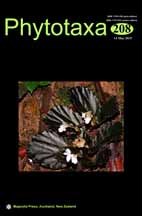Abstract
Putterlickia neglecta, a new species here described and illustrated, is known from South Africa (Mpumalanga and north-eastern KwaZulu-Natal), Swaziland and southern Mozambique. It is considered a near-endemic to the Maputaland Centre of Endemism. Plants grow as a shrub or small tree in savanna and thicket, or in the understory of inland, coastal and dune forests. Vegetatively it superficially resembles P. verrucosa, the species with which it has hitherto most often been confused. Both species have stems with prominently raised lenticels, but P. neglecta differs from P. verrucosa in having sessile to subsessile leaves with mostly entire, revolute leaf margins, flowers borne on pedicels 8–15 mm long, with petals up to 6 mm long and spreading or slightly recurved. Putterlickia verrucosa has leaves with distinct petioles, spinulose-denticulate margins, much smaller flowers borne on pedicels up to 4 mm long, with petals up to 2 mm long and erect or slightly spreading. The relatively large flowers of P. neglecta resemble those of P. pyracantha, but the latter differs in having stems with obscure or sunken lenticels, leaf margins entire or spinulose-denticulate and inflorescence axes as well as pedicels usually reddish. A comparative table to distinguish among the five currently recognized species of Putterlickia is provided.

